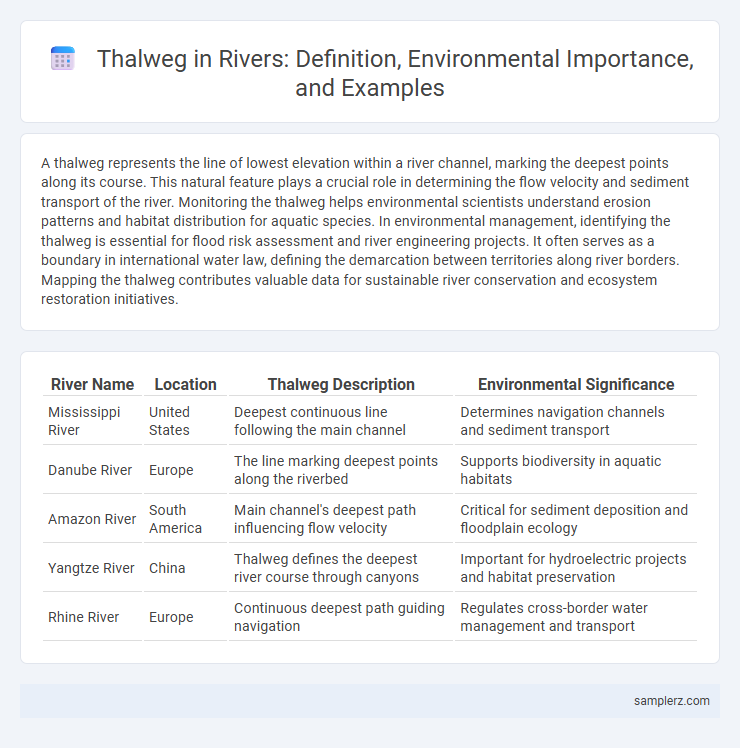A thalweg represents the line of lowest elevation within a river channel, marking the deepest points along its course. This natural feature plays a crucial role in determining the flow velocity and sediment transport of the river. Monitoring the thalweg helps environmental scientists understand erosion patterns and habitat distribution for aquatic species. In environmental management, identifying the thalweg is essential for flood risk assessment and river engineering projects. It often serves as a boundary in international water law, defining the demarcation between territories along river borders. Mapping the thalweg contributes valuable data for sustainable river conservation and ecosystem restoration initiatives.
Table of Comparison
| River Name | Location | Thalweg Description | Environmental Significance |
|---|---|---|---|
| Mississippi River | United States | Deepest continuous line following the main channel | Determines navigation channels and sediment transport |
| Danube River | Europe | The line marking deepest points along the riverbed | Supports biodiversity in aquatic habitats |
| Amazon River | South America | Main channel's deepest path influencing flow velocity | Critical for sediment deposition and floodplain ecology |
| Yangtze River | China | Thalweg defines the deepest river course through canyons | Important for hydroelectric projects and habitat preservation |
| Rhine River | Europe | Continuous deepest path guiding navigation | Regulates cross-border water management and transport |
Introduction to Thalweg in River Systems
The thalweg in river systems represents the line connecting the lowest points along the riverbed, marking the deepest channel where water flow is fastest. This feature plays a crucial role in shaping river morphology, influencing sediment transport and erosion patterns. Understanding the thalweg is essential for effective river management, navigation, and habitat preservation.
Defining Thalweg: Meaning and Importance
The thalweg represents the line of lowest elevation within a river channel, marking the path of maximum flow velocity and deepest water. Understanding the thalweg is crucial for river navigation, sediment transport studies, and flood risk management, as it influences channel morphology and habitat distribution. Accurate mapping of the thalweg assists in optimizing hydraulic engineering projects and maintaining ecological balance in riparian environments.
Natural Formation of Thalweg in Rivers
The thalweg in rivers represents the natural line of deepest flow, typically forming through continuous water erosion along the riverbed where velocity is greatest. Sediment transport and channel morphology interact dynamically, carving this path that guides the main current and influences river navigation and habitat distribution. Thalwegs often shift position in response to seasonal flow variations, sediment load changes, and riverbank erosion processes.
Notable Thalweg Examples Worldwide
The Amazon River features a prominent thalweg, marking the deepest continuous line along its channel, crucial for navigation and sediment transport. In Europe, the Danube River's thalweg serves as an important geopolitical boundary between countries such as Serbia and Croatia. The Mississippi River's thalweg influences floodplain dynamics and plays a significant role in shaping aquatic habitats and sediment distribution.
Thalweg and River Channel Migration
The thalweg represents the line of deepest flow within a river channel, guiding sediment transport and influencing erosion patterns. River channel migration occurs as the thalweg shifts laterally due to variations in flow velocity and sediment deposition. Understanding the interaction between thalweg dynamics and river channel migration is essential for predicting floodplain development and managing habitat diversity.
Thalweg’s Role in River Biodiversity
The thalweg, representing the deepest continuous line along a riverbed, plays a critical role in shaping aquatic habitats and supporting river biodiversity. By guiding water flow and sediment transport, it creates diverse microhabitats that foster the coexistence of various fish species, invertebrates, and plant life. This dynamic environment enhances nutrient distribution and oxygen levels, crucial factors for maintaining healthy ecosystems.
Human Impacts on Thalweg Patterns
Human activities such as dam construction and river channelization significantly alter thalweg patterns, disrupting natural flow and sediment transport. These changes lead to increased erosion, habitat loss, and reduced biodiversity along the river corridor. Understanding human impacts on thalweg dynamics is crucial for sustainable river management and ecosystem restoration efforts.
Thalweg in River Engineering Projects
The thalweg represents the deepest continuous line along a riverbed, critical for hydraulic modeling and flood management in river engineering projects. Accurate identification of the thalweg enables optimized channel design, sediment transport prediction, and the placement of structures such as bridges and levees. Engineers utilize thalweg data to enhance river navigation safety and minimize erosion through targeted interventions.
Thalweg and Floodplain Management
The thalweg represents the deepest continuous line along a riverbed, crucial for understanding flow velocity and sediment transport. Accurate mapping of the thalweg guides floodplain management by identifying areas prone to erosion and deposition, thereby informing levee design and habitat restoration. Integrating thalweg data with hydrological models enhances flood risk assessments and supports sustainable river engineering practices.
Conservation Strategies for Thalweg Preservation
Thalweg preservation in riverine ecosystems enhances water flow and habitat diversity, crucial for maintaining aquatic biodiversity and preventing erosion. Conservation strategies include establishing buffer zones with native vegetation to reduce sediment runoff and implementing controlled flow regulation to preserve natural river morphology. Monitoring thalweg shifts through remote sensing and GIS technology supports adaptive management practices to sustain river health and ecological integrity.

example of thalweg in river Infographic
 samplerz.com
samplerz.com